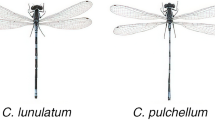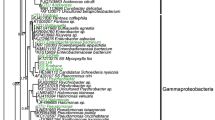Abstract
The endemic New Zealand weta is an enigmatic insect. Although the insect is well known by its distinctive name, considerable size, and morphology, many basic aspects of weta biology remain unknown. Here, we employed cultivation-independent enumeration techniques and rRNA gene sequencing to investigate the gut microbiota of the Auckland tree weta (Hemideina thoracica). Fluorescence in situ hybridisation performed on different sections of the gut revealed a bacterial community of fluctuating density, while rRNA gene-targeted amplicon pyrosequencing revealed the presence of a microbial community containing high bacterial diversity, but an apparent absence of archaea. Bacteria were further studied using full-length 16S rRNA gene sequences, with statistical testing of bacterial community membership against publicly available termite- and cockroach-derived sequences, revealing that the weta gut microbiota is similar to that of cockroaches. These data represent the first analysis of the weta microbiota and provide initial insights into the potential function of these microorganisms.






Similar content being viewed by others
References
Amann RI, Binder BJ, Olson RJ, Chisholm SW, Devereux R, Stahl DA (1990) Combination of 16S rRNA-targeted oligonucleotide probes with flow cytometry for analyzing mixed microbial populations. Appl Environ Microbiol 56:1919–1925
Boucias DG, Cai Y, Sun Y, Lietze V-U, Sen R, Raychoudhury R, Scharf ME (2013) The hindgut lumen prokaryotic microbiota of the termite Reticulitermes flavipes and its responses to dietary lignocellulose composition. Mol Ecol 22:1836–1853
Broderick NA, Raffa KF, Goodman RM, Handelsman J (2004) Census of the bacterial community of the Gypsy Moth larval midgut by using culturing and culture-independent methods. Appl Environ Microbiol 70:292–300
Cabrera BJ, Su N-Y, Scheffrahn RH, Oi FM, Koehler PG (2005) Formosan Subterranean Termite. ENY-216. 2001. Florida Cooperative Extension Service, Institute of Food and Agricultural Sciences, University of Florida, Gainesville
Cary PRL (1983) Diet of the ground weta Zealandosandrus gracilis (Orthoptera: Stenopelmatidae). NZ J Zool 10:295–298
Daims H, Brühl A, Amann R, Schleifer KH, Wagner M (1999) The domain-specific probe EUB338 is insufficient for the detection of all Bacteria: development and evaluation of a more comprehensive probe set. Syst Appl Microbiol 22:434–444
Dietrich C, Köhler T, Brune A (2014) The cockroach origin of the termite gut microbiota: patterns in bacterial community structure reflect major evolutionary events. Appl Environ Microbiol 80:2261–2269
Diez B, Pedrós-Alió C, Marsh TL, Massana R (2001) Application of Denaturing Gradient Gel Electrophoresis (DGGE) to study the diversity of marine picoeukaryotic assemblages and comparison of DGGE with other molecular techniques. Appl Environ Microbiol 67:2942–2951
Dröge S et al (2005) In vitro and in vivo sulfate reduction in the gut contents of the termite Mastotermes darwiniensis and the rose-chafer Pachnoda marginata. J Gen Appl Microbiol 51:57–64
Fontanetti CS, Zefa E (2000) Morphological characterization of the proventriculus of Gryllus assimilis Fabricius (Orthoptera, Gryllidae). Revista Brasileira de Zoologia 17:193–198
Gaston KJ (1991) The magnitude of global insect species richness. Conserv Biol 6:293–296
Gibbs GW (2006) Ghosts of Gondwana : the history of life in New Zealand. Craig Potton Publishing, Nelson
Gijzen HJ, Barughare M (1992) Contribution of anaerobic protozoa and methanogens to hindgut metabolic activities of the American cockroach, Periplaneta americana. Appl Environ Microbiol 58:2565–2570
Gijzen HJ, Broers CAM, Barughare M, Stumm CK (1991) Methanogenic bacteria as endosymbionts of the ciliate Nyctotherus ovalis in the cockroach. Appl Environ Microbiol 57:1630–1634
Gosables MJ et al (2011) Metatranscriptomic approach to analyze the functional human gut microbiota. PLoS One 6:e17447
Griffin MJ, Morgan-Richards M, Trewick SA (2011a) Is the tree weta Hemideina crassidens an obligate herbivore? NZ Nat Sci 36:11–19
Griffin MJ, Trewick SA, Wehi PM, Morgan-Richards M (2011b) Exploring the concept of niche convergence in a land without rodents: the case of weta as small mammals. NZ J Ecol 35:302–307
Grünwald S, Pilhofer M, Höll W (2010) Microbial associations in gut systems of wood- and bark-inhabiting longhorned beetles (Coleoptera: Cerambycidae). Syst Appl Microbiol 33:25–34
Idowu AB, Edema MO, Oyedepo MT (2009) Extracellular enzyme production by microflora from the gut region of the variegated grasshopper Zonocerus variegatus (Orthoptera: Pyrgomorphidae). Int J Trop Insect Sci 29:229–235
Kearse M et al (2012) Geneious Basic: an integrated and extendable desktop software platform for the organization and analysis of sequence data. Bioinformatics 28:1647–1649
Kelly CD (2011) Reproductive and physiological costs of repeated immune challenges in female Wellington tree weta (Orthoptera: Anostostomatidae). Biol J Linn Soc 104:38–46
Kittelmann S, Seedorf H, Walters WA, Clemente JC, Knight R, Gordon JI, Janssen PH (2013) Simultaneous amplicon sequencing to explore co-occurrence patterns of bacterial, archaeal and eukaryotic microorganisms in rumen microbial communities. PLoS One 8:e47879
Liu N et al (2013) Metagenomic insights into metabolic capacities of the gut microbiota in a fungus-cultivating termite (Odontotermes yunnanensis). PLoS One 8:e69184
Ludwig W et al (2004) ARB: a software environment for sequence data. Nucleic Acids Res 32:1363–1371
Maskell FG (1927) The anatomy of Hemideina thoracica. Trans NZ Inst 57:637–670
Matsui T, Tokuda G, Shinzato N (2009) Termites as functional gene resources. Recent Pat Biotechnol 3:10–18
Meehan CJ, Beiko RG (2014) A phylogenomic view of ecological specialization in the Lachnospiraceae, a family of digestive tract-associated bacteria. Genome Biol Evol 6:703–713
Neall VE, Trewick SA (2008) The age and origin of the Pacific islands: a geological overview. Philos Trans Royal Soc B 33:3293–3308
Novotny V, Basset Y, Miller SE, Weiblen GD, Bremer B, Cizek L, Drozd P (2002) Low host specificity of herbivorous insects in a tropical forest. Nature 416:841–844
Ohkuma M (2003) Termite symbiotic systems: efficient bio-recycling of lignocellulose. Appl Microbiol Biotechnol 61:1–9
Ohkuma M (2008) Symbioses of flagellates and prokaryotes in the gut of lower termites. Trends Microbiol 16:345–352
Oppert C, Klingerman WE, Willis JD, Oppert B, Jurat-Fuentes JL (2010) Prospecting for cellulolytic activity in insect digestive fluids. Comp Biochem Physiol B 155:145–154
Polz MF, Cavanaugh CM (1998) Bias in template-to-product ratios in multitemplate PCR. Appl Environ Microbiol 64:3724–3730
Pratt RC, Morgan-Richards M, Trewick SA (2008) Diversification of New Zealand weta (Orthoptera: Ensifera: Anostostomatidae) and their relationships in Australasia. Philos Trans Royal Soc Lond B 363:3427–3437
Pruesse E, Quast C, Knittel K, Fuchs BM, Ludwig W, Peplies J, Glöckner FO (2007) SILVA: a comprehensive online resource for quality checked and aligned ribosomal RNA sequence data compatible with ARB. Nuclic Acids Res 35:7188–7196
R Core Team (2012) R: a language and environment for statistical computing. http://www.R-project.org/
Sabree ZL, Moran NA (2014) Host-specific assemblages typify gut microbial communities of related insect species. SpringerPlus 3:138
Santo Domingo JW, Kaufman MG, Klug MJ, Holben WE, Harris R, Tiedje JM (1998a) Influence of diet on the structure and function of the bacterial hindgut community of crickets. Mol Ecol 7:761–767
Santo Domingo JW, Kaufman MG, Klug MJ, Tiedje JM (1998b) Characterization of the cricket hindgut microbiota with fluorescently labeled rRNA-targeted oligonucleotide probes. Appl Environ Microbiol 64:752–755
Sato T, Hongoh Y, Noda S, Hattori S, Ui S, Ohkuma M (2009) Candidatus Desulfovibrio trichonymphae, a novel intracellular symbiont of the flagellate Trichonympha agilis in termite gut. Environ Microbiol 11:1007–1015
Schloss PD, Gevers D, Westcott SL (2011) Reducing the effects of PCR amplification and sequencing artifacts on 16S rRNA-based studies. PLoS One 6:e27310
Sinclair BJ, Wharton D (1997) Avoidance of Intracellular Freezing by the Freezing-Tolerant New Zealand Alpine Weta Hemideina maori (Orthoptera: Stenopelmatidae). J Insect Physiol 43:621–625
Spring S, Lins U, Amann R, Schleifer KH, Ferreira LCS, Esquivel DMS, Farina M (1998) Phylogenetic affiliation and ultrastructure of uncultured magnetic bacteria with unusually large magnetosomes. Arch Microbiol 169:136–147
Taylor MW, Schupp PJ, Dahllöf I, Kjelleberg S, Steinberg PD (2004) Host specificity in marine sponge-associated bacteria, and potential implications for marine microbial diversity. Environ Microbiol 6:121–130
Thompson CL, Vier R, Mikaelyan A, Wienemann T, Brune A (2012) ‘Candidatus Arthromitus’ revised: segmented filamentous bacteria in arthropod guts are members of Lachnospiraceae. Environ Microbiol 14:1454–1465
Tokura M, Ohkuma M, Kudo T (2000) Molecular phylogeny of methanogens associated with flagellated protists in the gut and with the gut epithelium of termites. FEMS Microbiol Ecol 33:233–240
Trewick SA, Morgan-Richards M (1995) On the distribution of tree weta in the North Island, New Zealand. J Royal Soc NZ 25:485–493
Wang Q, Garrity GM, Tiedje JM, Cole JR (2007) Naïve Bayesian classifier for rapid assignment of rRNA sequences into the new bacterial taxonomy. Appl Environ Microbiol 73:5261–5267
Webster NS, Negri AP, Munro MMHG, Battershill CN (2004) Diverse microbial communities inhabit Antarctic sponges. Environ Microbiol 6:288–300
Wehi PM, Hicks BJ (2010) Isotopic fractionation in a large herbivorous insect, the Auckland tree weta. J Insect Physiol 56:1877–1882
Wehi PM, Jorgensen M, Morgan-Richards M (2013) Sex- and season-dependent behaviour in a flightless insect, the Auckland tree weta (Hemideina thoracica). NZ J Ecol 37:75–83
Werner JJ et al (2012) Impact of training sets on classification of high-throughput bacterial 16 s rRNA gene surveys. ISME J 6:94–103
Wharton D (2011) Cold tolerance of New Zealand alpine insects. J Insect Physiol 57:1090–1095
White TJ, Bruns T, Lee S, Taylor J (1990) Amplification and direct sequencing of fungal ribosomal RNA genes for phylogenetics. In: Innis M, Gelfand DH, Shinsky JJ, White TJ (eds) In PCR protocols: a guide to methods and applications. Academic Press, New York, pp 315–322
Willis JD, Klingerman WE, Oppert C, Oppert B, Jurat-Fuentes JL (2010) Characterization of cellulolytic activity from digestive fluids of Dissosteira carolina (Orthoptera: Acrididae). Comp Biochem Physiol B 157:267–272
Wilson GC, Jamieson IG (2005) Does melanism influence the diet of the mountain stone weta Hemideina maori (Orthoptera: Anostostomatidae)? NZ J Ecol 29:149–152
Woyke T, Smith D (2008) 16S/18S rRNA PCR Library Creation http://my.jgi.doe.gov/general/protocols/SOP_16S18S_rRNA_PCR_Library_Creation.pdf. Accessed 26 Nov 2013
Zhang M et al (2014) Phylogenetic and functional analysis of gut microbiota of a fungus-growing higher termite: Bacteroidetes from higher termites are a rich source of β-glucosidase genes. Microb Ecol 68:416–425
Acknowledgments
The work conducted by the U.S. Department of Energy Joint Genome Institute is supported by the Office of Science of the U.S. Department of Energy under Contract No. DE-AC02-05CH11231. We thank S. Tringe, S. Malfatti, and T. Glavina del Rio (JGI) for their helpful advice, M. Dhami for providing the 18S rRNA gene primers, and R. Kleinpaste and G. Holwell for supplying weta. DWW and MD were supported by University of Auckland Doctoral Scholarships.
Author information
Authors and Affiliations
Corresponding author
Additional information
Communicated by Andreas Brune.
Electronic supplementary material
Below is the link to the electronic supplementary material.
Rights and permissions
About this article
Cite this article
Waite, D.W., Dsouza, M., Biswas, K. et al. Microbial community structure in the gut of the New Zealand insect Auckland tree weta (Hemideina thoracica). Arch Microbiol 197, 603–612 (2015). https://doi.org/10.1007/s00203-015-1094-3
Received:
Revised:
Accepted:
Published:
Issue Date:
DOI: https://doi.org/10.1007/s00203-015-1094-3




